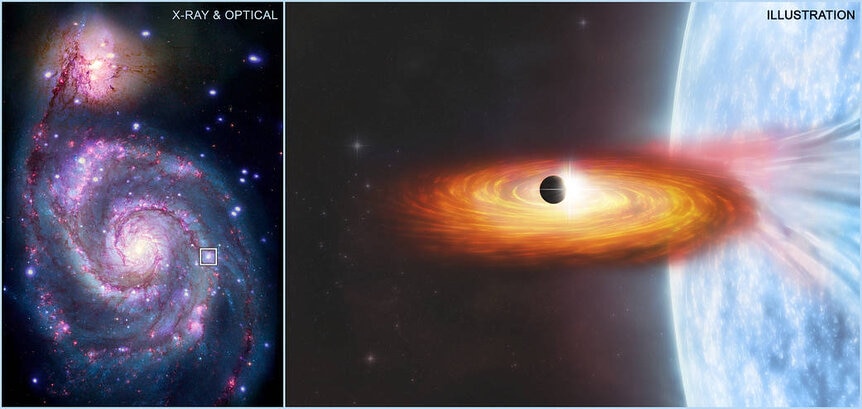Create a free profile to get unlimited access to exclusive videos, sweepstakes, and more!
Wait...is that the first planet we’re seeing outside of our galaxy?
Somewhere in the galaxy Messier 51, NASA's Chandra X-ray Observatory saw what might be a planet.

Exoplanets seem to materialize out of nowhere all the time, but every single one of them has been found in our own galaxy. Until now.
Planets in other galaxies are all over science fiction, and while they probably do exist, we haven’t found another Vulcan or Betazed just yet. NASA’s Chandra X-ray Observatory might have spotted one. Somewhere in the galaxy Messier 51 (the type of mesmerizing spiral galaxy that would make an amazing desktop background), 28 million light years away, the telescope caught a mystery object blocking out starlight. That object may or may not be a planet.
Researcher Rosanne Di Stefano of the Center for Astrophysics, Harvard & Smithsonian, and her team had been searching for exoplanets outside of our galaxy by looking for anything that made it look as if the brightness of X-rays in X-ray binary star systems was temporarily switched off. She led a study recently published in Nature Astronomy.
“We searched for transits of the X-ray source in X-ray binaries,” she told SYFY WIRE. “Because the source can be as small as or smaller than a planet, the passage of a planet in front of the source can produce a complete or near-complete eclipse for a short time.”
Whatever this thing is, if it is a planet, it has been figured out to be around the size of Saturn. This was determined by a model of the eclipse that gave an approximation of the size and speed of the planet candidate relative to the source of X-ray radiation. The X-ray source being small was an asset here. Transiting objects can easily make it go dark once they pass in front, and the dip in light shows up clearly for the telescope. Observations in optical light can be problematic because the light source is larger, and a planet in transit usually cannot block all of it.
Searching for X-ray transits could possibly allow the detection of planets much further away than ever. There is little to no excess light because the source is so tiny in comparison to stars giving off optical light, which is why the scientists have found what could be a planet in the binary system M51-ULS-1, which is thought to consist of a black hole or neutron star orbiting another star. That could mean the planet went through a tumultuous past. It might have been the victim of the supernova that resulted in a neutron star, which would mean it was badly irradiated.
“Whatever happened at the end of the life of the star that became the compact object, there was likely some mass lost from the system,” Di Stefano said. “A planet's orbit could widen. It is also possible that its interaction with the mass altered its orbit as well, possibly bringing it closer to the midplane of the binary's orbit.”
The so-called planet might have had a better fate if the other object in the binary is a black hole. Because black holes form from stars that collapse in on themselves (a supernova fail), the birth of one may be an energetic event, but not nearly so violent as a supernova. It might have escaped a radiation bath. Unfortunately, this object’s orbit was estimated to be so huge that nobody will be able to find out any more about whether it really is a planet for another 70 years, unless another method of observation happens to catch it journeying through some random part of its galaxy.
What this planet or wannabe planet has done is set a precedent. There are still two more galaxies Di Stefano is scouring for evidence of a possible planet — Messier 101 and Messier 104 — and she is not finished with M51 yet.
“Although we will not see another transit, the information we do have strongly supports the planet interpretation above any others, though we do not expect a complete proof,” she said. “The most important thing to do is to search for other candidate planets.”



























